苏教版七年级英语上册unit1教案
- 格式:doc
- 大小:49.00 KB
- 文档页数:8
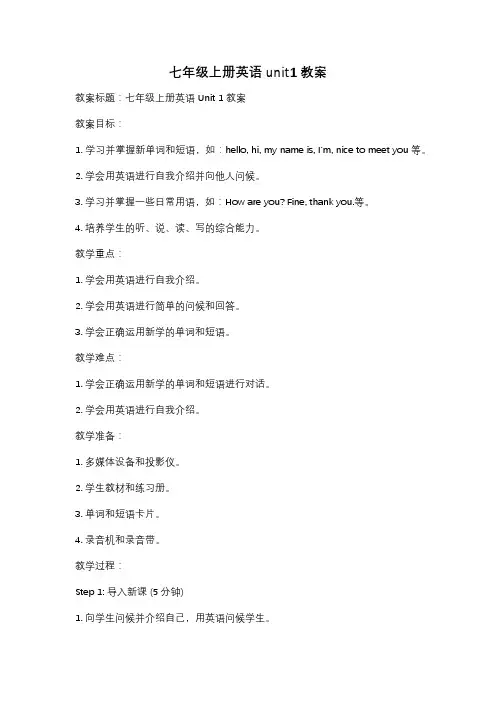
七年级上册英语 unit1教案教案标题:七年级上册英语 Unit 1 教案教案目标:1. 学习并掌握新单词和短语,如:hello, hi, my name is, I'm, nice to meet you等。
2. 学会用英语进行自我介绍并向他人问候。
3. 学习并掌握一些日常用语,如:How are you? Fine, thank you.等。
4. 培养学生的听、说、读、写的综合能力。
教学重点:1. 学会用英语进行自我介绍。
2. 学会用英语进行简单的问候和回答。
3. 学会正确运用新学的单词和短语。
教学难点:1. 学会正确运用新学的单词和短语进行对话。
2. 学会用英语进行自我介绍。
教学准备:1. 多媒体设备和投影仪。
2. 学生教材和练习册。
3. 单词和短语卡片。
4. 录音机和录音带。
教学过程:Step 1: 导入新课 (5分钟)1. 向学生问候并介绍自己,用英语问候学生。
2. 引入新单词和短语,如hello, hi, my name is, I'm, nice to meet you等。
教师可以通过图片、卡片等方式呈现。
Step 2: 单词和短语学习 (15分钟)1. 教师通过多媒体展示单词和短语,并发音示范。
2. 学生跟读并记忆新单词和短语。
3. 学生进行口头练习,用新学的单词和短语进行自我介绍和问候。
Step 3: 对话练习 (20分钟)1. 教师示范用新学的单词和短语进行对话,如:A: Hello, my name is Lily. What's your name?B: Hi, I'm Tom. Nice to meet you, Lily.2. 学生分组进行对话练习,教师逐一指导和纠正错误。
Step 4: 听力练习 (15分钟)1. 教师播放录音,学生听录音并完成相应的听力练习。
2. 教师播放录音,学生模仿录音内容进行口语练习。
Step 5: 语法讲解 (10分钟)1. 教师通过多媒体展示和讲解一些基本的语法知识,如:主语+谓语动词。
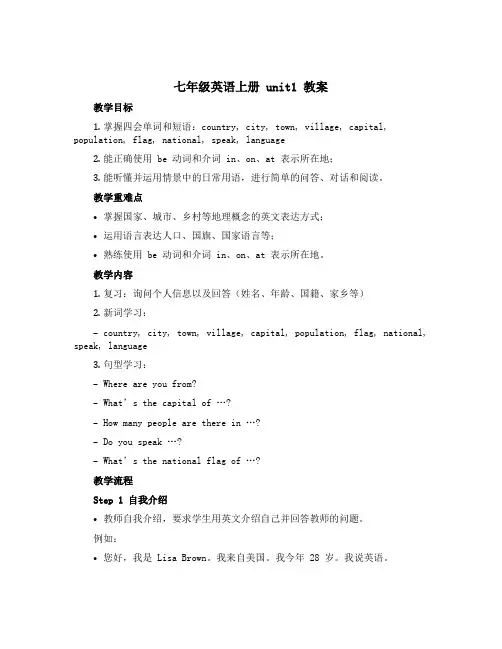
七年级英语上册 unit1 教案教学目标1.掌握四会单词和短语:country, city, town, village, capital, population, flag, national, speak, language2.能正确使用 be 动词和介词 in、on、at 表示所在地;3.能听懂并运用情景中的日常用语,进行简单的问答、对话和阅读。
教学重难点•掌握国家、城市、乡村等地理概念的英文表达方式;•运用语言表达人口、国旗、国家语言等;•熟练使用 be 动词和介词 in、on、at 表示所在地。
教学内容1.复习:询问个人信息以及回答(姓名、年龄、国籍、家乡等)2.新词学习:–country, city, town, village, capital, population, flag, national, speak, language3.句型学习:–Where are you from?–What’s the capital of …?–How many people are there in …?–Do you speak …?–What’s the national flag of …?教学流程Step 1 自我介绍•教师自我介绍,要求学生用英文介绍自己并回答教师的问题。
例如:•您好,我是 Lisa Brown。
我来自美国。
我今年 28 岁。
我说英语。
Step 2 国家、城市、乡村的英文表达•引导学生了解国家、城市、乡村等地理概念的英文表达方式,如:country, city, town, village。
例如:•教师出示地图,询问学生知道哪些国家的英文名称。
同时介绍 city, town, village 的英文表达方式,并请学生说出自己所在城市、乡村的英文名称。
Step 3 国家语言、国旗的英文表达•通过图片、视频等方式,介绍不同国家的国旗、国家语言等,并引导学生说出对应的英文表达方式。
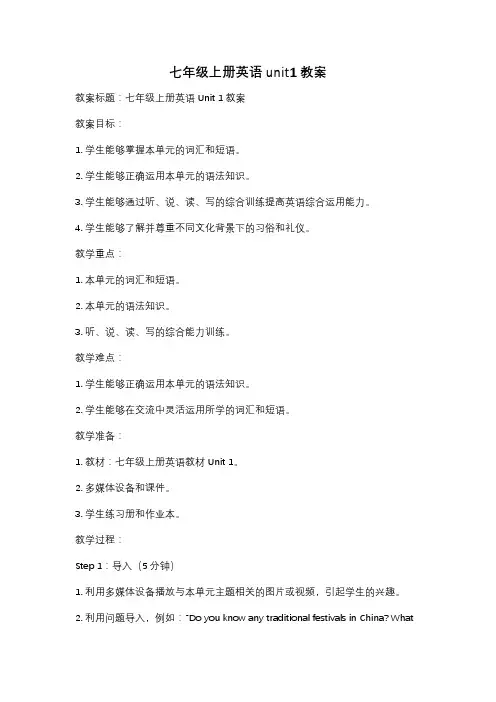
七年级上册英语unit1教案教案标题:七年级上册英语Unit 1教案教案目标:1. 学生能够掌握本单元的词汇和短语。
2. 学生能够正确运用本单元的语法知识。
3. 学生能够通过听、说、读、写的综合训练提高英语综合运用能力。
4. 学生能够了解并尊重不同文化背景下的习俗和礼仪。
教学重点:1. 本单元的词汇和短语。
2. 本单元的语法知识。
3. 听、说、读、写的综合能力训练。
教学难点:1. 学生能够正确运用本单元的语法知识。
2. 学生能够在交流中灵活运用所学的词汇和短语。
教学准备:1. 教材:七年级上册英语教材Unit 1。
2. 多媒体设备和课件。
3. 学生练习册和作业本。
教学过程:Step 1:导入(5分钟)1. 利用多媒体设备播放与本单元主题相关的图片或视频,引起学生的兴趣。
2. 利用问题导入,例如:“Do you know any traditional festivals in China? Whatdo people usually do during these festivals?”Step 2:新课呈现(15分钟)1. 呈现本单元的生词和短语,并帮助学生正确发音和理解词义。
2. 利用多媒体设备和课件呈现本单元的语法知识,并通过示例句子进行解释和练习。
Step 3:听说训练(15分钟)1. 听力训练:播放相关录音,让学生听并回答相关问题,提高他们的听力理解能力。
2. 口语训练:利用小组或全班讨论的方式,让学生运用所学的词汇和短语进行口语练习,例如:“What do you usually do on your birthday?”Step 4:阅读训练(15分钟)1. 学生阅读本单元的课文,并回答相关问题,提高他们的阅读理解能力。
2. 学生进行小组或个人阅读练习,根据所给的提示写一篇关于自己或朋友生日庆祝的短文。
Step 5:写作训练(15分钟)1. 学生根据所学的语法知识和词汇,写一篇关于自己或朋友生日庆祝的邀请函。
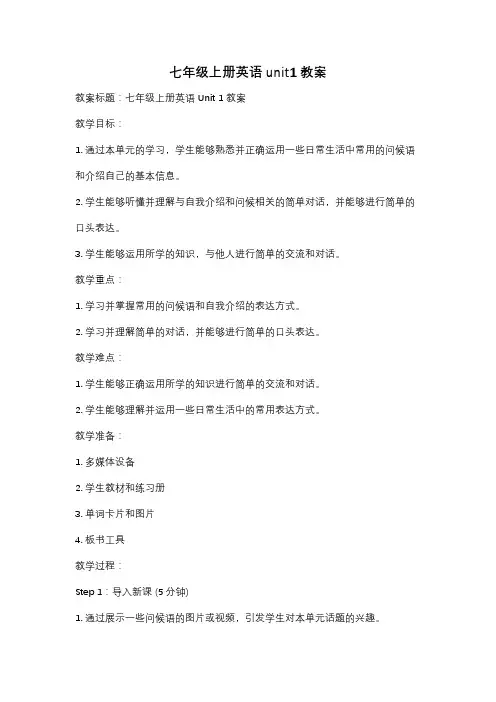
七年级上册英语unit1教案教案标题:七年级上册英语 Unit 1 教案教学目标:1. 通过本单元的学习,学生能够熟悉并正确运用一些日常生活中常用的问候语和介绍自己的基本信息。
2. 学生能够听懂并理解与自我介绍和问候相关的简单对话,并能够进行简单的口头表达。
3. 学生能够运用所学的知识,与他人进行简单的交流和对话。
教学重点:1. 学习并掌握常用的问候语和自我介绍的表达方式。
2. 学习并理解简单的对话,并能够进行简单的口头表达。
教学难点:1. 学生能够正确运用所学的知识进行简单的交流和对话。
2. 学生能够理解并运用一些日常生活中的常用表达方式。
教学准备:1. 多媒体设备2. 学生教材和练习册3. 单词卡片和图片4. 板书工具教学过程:Step 1:导入新课 (5分钟)1. 通过展示一些问候语的图片或视频,引发学生对本单元话题的兴趣。
2. 向学生提问,引导他们回忆并分享自己在日常生活中常用的问候语。
Step 2:新课讲解 (15分钟)1. 教师通过多媒体展示幻灯片或板书,介绍并讲解本单元的目标和重点内容。
2. 教师逐一讲解和演示常用的问候语和自我介绍的表达方式,并引导学生进行模仿和练习。
3. 教师通过示范对话,让学生理解并掌握如何进行简单的交流和对话。
Step 3:练习与巩固 (20分钟)1. 学生进行小组活动,每组选择一位代表进行自我介绍,其他组员进行提问和回答。
2. 学生进行角色扮演,模拟真实生活场景中的问候和自我介绍对话,并与同伴进行互动练习。
3. 教师组织游戏活动,如快速问候比赛,让学生通过游戏巩固所学的问候语和自我介绍的表达方式。
Step 4:拓展与应用 (10分钟)1. 学生根据教师提供的情景,编写简短的对话,并进行表演。
2. 学生自由发挥,与同伴进行真实的交流和对话,运用所学的知识进行实际应用。
Step 5:课堂总结 (5分钟)1. 教师对本节课的重点内容进行总结,并强调学生在日常生活中的实际应用价值。
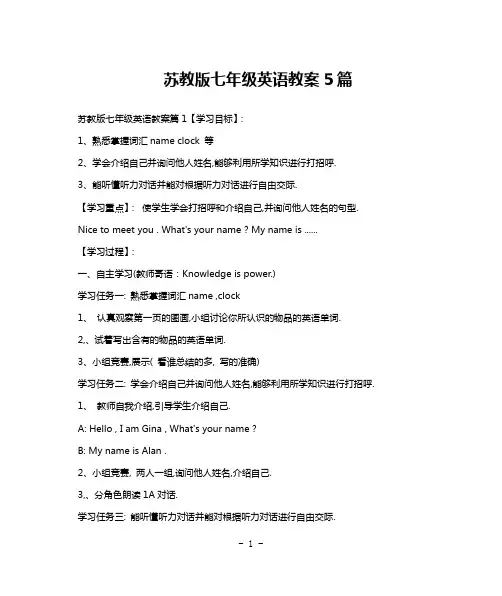
苏教版七年级英语教案5篇苏教版七年级英语教案篇1【学习目标】:1、熟悉掌握词汇name clock 等2、学会介绍自己并询问他人姓名,能够利用所学知识进行打招呼.3、能听懂听力对话并能对根据听力对话进行自由交际.【学习重点】:使学生学会打招呼和介绍自己,并询问他人姓名的句型. Nice to meet you . What's your name ? My name is ......【学习过程】:一、自主学习(教师寄语:Knowledge is power.)学习任务一: 熟悉掌握词汇name ,clock1、认真观察第一页的图画,小组讨论你所认识的物品的英语单词.2,、试着写出含有的物品的英语单词.3、小组竞赛,展示( 看谁总结的多, 写的准确)学习任务二: 学会介绍自己并询问他人姓名,能够利用所学知识进行打招呼.1、教师自我介绍,引导学生介绍自己.A: Hello , I am Gina , What's your name ?B: My name is Alan .2、小组竞赛, 两人一组,询问他人姓名,介绍自己.3,、分角色朗读1A对话.学习任务三: 能听懂听力对话并能对根据听力对话进行自由交际.1,、听录音, 给1B 的对话编号.2、根据听力对话进行自由交际.3、小组竞赛, 展示对话交际。
二、合作共建(教师寄语:Many hands make light work. )小组讨论我们所学的英语名字和汉语名字的区别, 如何用英语拼写你的名字?三、系统总结(教师寄语:No man can do two things at once.) 1,、归纳你所学到的问候语.2、自己编写一个打招呼并询问姓名的小对话.四、诊断评价(一) 单项选择.1. _______your name ? My name is Gina .A. WhatB. What'sC. WhoD. which2. Good morning , Miss Wang ! _____________!A. HelloB.HiC. Nice to meet youD. Good morning3. I _______Sally , What______ your name ?A. am ,isB. is , amC. is , isD.am, am4. ______name is Li lei .A. IB. I amC. MyD. you5.—_______, What's your name ?—John Green .A. HiB. OkC. sorryD. Excuse me(二) 写出下列单词的完全形式, 并写出汉语意思.I'm _________ __________ what's __________ ________name 's ___________ __________(三)写出下列单词.时钟_______ 我的________ 你的___________ 名字_______ 遇见_________(四)尝试翻译下列句子.1. 见到你很高兴. _________________________________.2.我叫王小雨. ____________________________________.3. 你叫什么名字? ____________________________________(五) 根据情景补全对话.A: Good afternoon !B: ____________________!A; I ______Lucy . _________your name ?B: My ______ is Jim . Nice to ______you !A: _______________________________.五、【课后反思】苏教版七年级英语教案篇2教学目标Key words: short, curly, long, tall, straight hair, a medium build, thin, heavy, bald; brown, blonde;glasses, hair, beard, mustache.New language:What do you look like? I’m short. And I have curly hair.What do they look like? They’re medium height. And they have short hair.What does he look like? He’s heavy and he wears glasses.What does she look like? She’s thin and she has long hair.教学重难点Importance: Describing people. Such as tall or short…and who has long hair and short hair…Difficulties: use the sentences correctly to describe the physical appearance.III. Teaching Steps:教学工具课件教学过程Step 1 GreetingsStep 2 Ask some students to name some ways of describing people. Start students off with examples such as tall and short. Point out various students in the class and ask students to say if they are tall or short.Step 3 Some new words about this part(1a) This activity introduces the key vocabulary. Ask students to read the list of words. Point to the letters next to the people in the picture. Point out the sample answer. At last, check the answers.(1b) This activity provides guided listening and writing practice the target language.Play the recording the first time, then , play it again, this time, students fill in theblanks in the speech bubbles.Correct the answers.Language points: 1.He’s the tall boy with the curly hair.(1c)This activity provides guided oral practice using the target language. Ask the students to ask and answer the questions. Then have students work in pairs. As they talk, move around the room monitoring their work.Language points:2.What does your friend look like?你的朋友长得什么样?look like “看起来像,看起来是……的样子”like 作介词,意为“像….”eg. What’s he like?Jack is very like his father.look like 看起来像The girl look like her mother.look 看起来后加形容词作表语His sister looks happy.look the same 看起来很像The twins look the same.(2a)This activity provides guided listening practice using the target language.Point to the list of nice phrases and ask a students to read them to the class. Play the recording twice. And complete the answers. Then correct the answers.(2b)Ask the students to listen to the descriptions and write the words in the correct column after each person’s name.(3)Writing practice: Have students do the activity individually. Offer help as necessary.(Grammar focus) Review the grammar box. Ask students to read the questions andanswers. Point out: ①does, goes-----you, they do, go--------he, she.②I’m, they’re, he’s and she’s -----height(3a)This activity provides reading practice using the target language. Have a student read the first description. Check the answers.Language points:3.She has a medium build, and she has long hair. 她体格中等,留着长发。
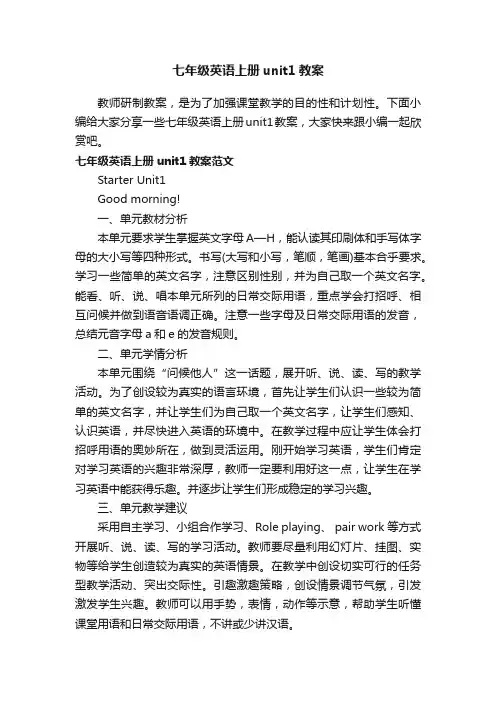
七年级英语上册unit1教案教师研制教案,是为了加强课堂教学的目的性和计划性。
下面小编给大家分享一些七年级英语上册unit1教案,大家快来跟小编一起欣赏吧。
七年级英语上册unit1教案范文Starter Unit1Good morning!一、单元教材分析本单元要求学生掌握英文字母A—H,能认读其印刷体和手写体字母的大小写等四种形式。
书写(大写和小写,笔顺,笔画)基本合乎要求。
学习一些简单的英文名字,注意区别性别,并为自己取一个英文名字。
能看、听、说、唱本单元所列的日常交际用语,重点学会打招呼、相互问候并做到语音语调正确。
注意一些字母及日常交际用语的发音,总结元音字母a和e的发音规则。
二、单元学情分析本单元围绕“问候他人”这一话题,展开听、说、读、写的教学活动。
为了创设较为真实的语言环境,首先让学生们认识一些较为简单的英文名字,并让学生们为自己取一个英文名字,让学生们感知、认识英语,并尽快进入英语的环境中。
在教学过程中应让学生体会打招呼用语的奥妙所在,做到灵活运用。
刚开始学习英语,学生们肯定对学习英语的兴趣非常深厚,教师一定要利用好这一点,让学生在学习英语中能获得乐趣。
并逐步让学生们形成稳定的学习兴趣。
三、单元教学建议采用自主学习、小组合作学习、Role playing、 pair work等方式开展听、说、读、写的学习活动。
教师要尽量利用幻灯片、挂图、实物等给学生创造较为真实的英语情景。
在教学中创设切实可行的任务型教学活动、突出交际性。
引趣激趣策略,创设情景调节气氛,引发激发学生兴趣。
教师可以用手势,表情,动作等示意,帮助学生听懂课堂用语和日常交际用语,不讲或少讲汉语。
四、单元课时分配本单元可用2课时完成教学任务:(1a-2e) 用1课时(3a-4d) 用1课时(1a-2d)一、教学目标:1. 语言知识目标:1) 能掌握以下词汇:字母Aa ~ Hh, good, morning, Good morning!, hi, hello2) 能掌握以下句型:① Good morning, Helen!② Hello, Frank!③ Hi, Bob!3) 能理解用英语打招呼的不同说法,并能灵活运用。
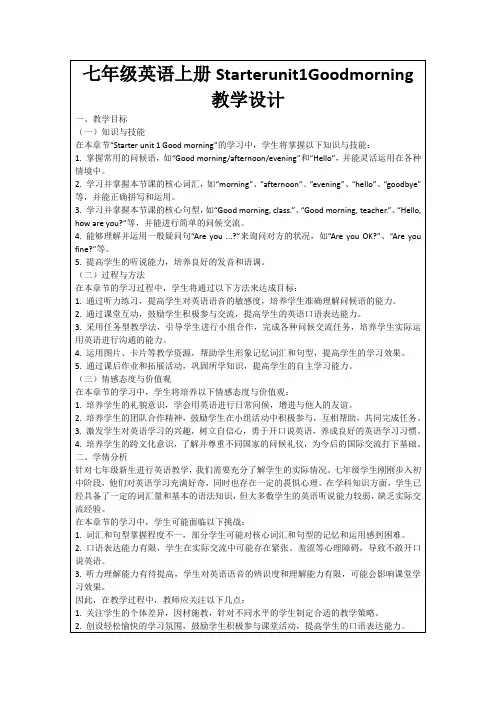
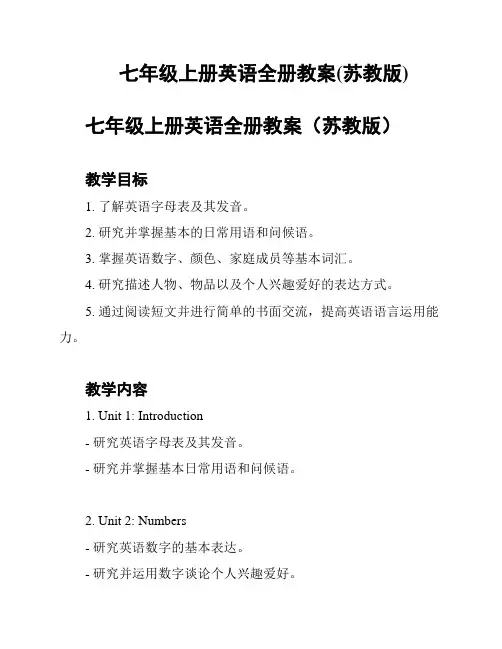
七年级上册英语全册教案(苏教版)七年级上册英语全册教案(苏教版)教学目标1. 了解英语字母表及其发音。
2. 研究并掌握基本的日常用语和问候语。
3. 掌握英语数字、颜色、家庭成员等基本词汇。
4. 研究描述人物、物品以及个人兴趣爱好的表达方式。
5. 通过阅读短文并进行简单的书面交流,提高英语语言运用能力。
教学内容1. Unit 1: Introduction- 研究英语字母表及其发音。
- 研究并掌握基本日常用语和问候语。
2. Unit 2: Numbers- 研究英语数字的基本表达。
- 研究并运用数字谈论个人兴趣爱好。
3. Unit 3: Colors- 研究并掌握英语颜色的基本词汇。
- 进行听说训练,描述物品的颜色。
4. Unit 4: Family- 研究家庭成员的英文表达方式。
- 进行角色扮演,描述自己的家庭情况。
5. Unit 5: Describing People- 研究描述人物外貌和性格特点的词汇和句型。
- 进行口语练,描述身边的人。
6. Unit 6: Hobbies- 研究并掌握谈论个人兴趣爱好的词汇和问句。
- 进行小组活动,分享各自的兴趣爱好。
教学方法1. 情境导入法:通过图片、视频等形式引导学生进入研究情境。
2. 听说训练法:通过听取和模仿的方式培养学生的听说能力。
3. 角色扮演法:让学生扮演不同角色进行对话练,提高口语表达能力。
4. 小组活动法:借助小组合作的方式,增强学生的交际能力。
教学评估1. 课堂练:每个单元结束时进行的课堂小测验,检验学生对所学内容的掌握情况。
2. 书面作业:布置相应的书面作业,要求学生用英语书写简单的短文。
3. 口头表达评估:通过角色扮演和小组活动中的口语表达情况进行评估。
教学资源1. 苏教版英语七年级上册教材及配套CD-ROM。
2. 多媒体课件:包含图片、视频等多媒体资源,用于辅助教学。
3. 教学笔记和练册:记录研究重点和巩固练。
总结本教案根据苏教版七年级上册英语教材编写,旨在培养学生的英语听说能力和基础词汇掌握能力。
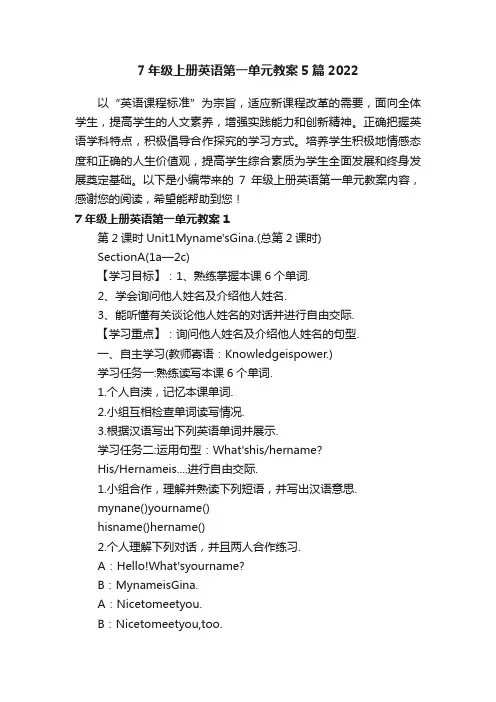
7年级上册英语第一单元教案5篇2022以“英语课程标准”为宗旨,适应新课程改革的需要,面向全体学生,提高学生的人文素养,增强实践能力和创新精神。
正确把握英语学科特点,积极倡导合作探究的学习方式。
培养学生积极地情感态度和正确的人生价值观,提高学生综合素质为学生全面发展和终身发展奠定基础。
以下是小编带来的7年级上册英语第一单元教案内容,感谢您的阅读,希望能帮助到您!7年级上册英语第一单元教案1第2课时Unit1Myname'sGina.(总第2课时)SectionA(1a—2c)【学习目标】:1、熟练掌握本课6个单词.2、学会询问他人姓名及介绍他人姓名.3、能听懂有关谈论他人姓名的对话并进行自由交际.【学习重点】:询问他人姓名及介绍他人姓名的句型.一、自主学习(教师寄语:Knowledgeispower.)学习任务一:熟练读写本课6个单词.1.个人自渎,记忆本课单词.2.小组互相检查单词读写情况.3.根据汉语写出下列英语单词并展示.学习任务二:运用句型:What'shis/hername?His/Hernameis....进行自由交际.1.小组合作,理解并熟读下列短语,并写出汉语意思.mynane()yourname()hisname()hername()2.个人理解下列对话,并且两人合作练习.A:Hello!What'syourname?B:MynameisGina.A:Nicetomeetyou.B:Nicetomeetyou,too.A:What'shername?B:HernameisJenny.3.小组合作,练习自己的对话.4.对抗组开展竞赛,展示自己的对话.学习任务三:听听力完成2a,2b.1.个人看图,理解四幅图画,思考图画中人是在谈论他人还是对方.2.听听力,给四幅图画编号.3.小组为单位,熟读2b中的名字。
4.听听力,完成2b.二、合作共建(教师寄语:Manyhandsmakelightwork.)讨论下面两句话如何用英语表达.1.他叫Bob.2.她叫Jenny.三、系统总结(教师寄语:Nomancandotwothingsatonce.)根据提示,完成下列问答.______________What's_______name?_______is...._______________四、诊断评价1、写出下列短语.(1)我的时钟(2)你的问题(3)他的名字(4)她的回答2、根据句意及首字母补全单词。
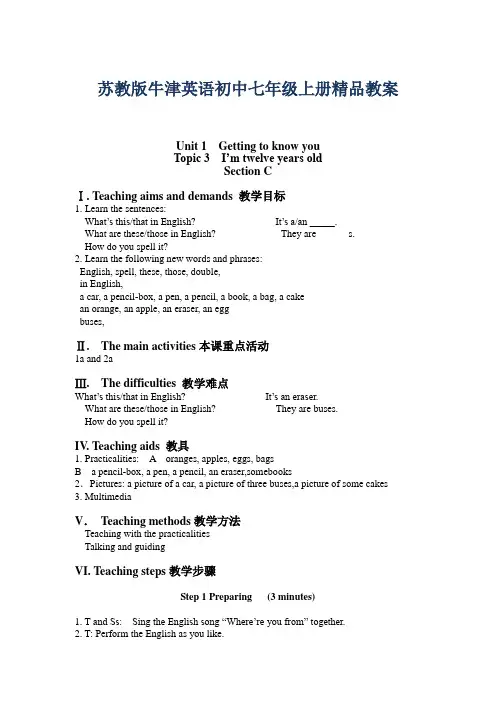
苏教版牛津英语初中七年级上册精品教案Unit 1 Getting to know youTopic 3 I’m twelve years oldSection CⅠ. Teaching aims and demands 教学目标1. Learn the sentences:What’s this/that in English? It’s a/an _____.What are these/those in English? They are ______s.How do you spell it?2. Learn the following new words and phrases:English, spell, these, those, double,in English,a car, a pencil-box, a pen, a pencil, a book, a bag, a cakean orange, an apple, an eraser, an eggbuses,Ⅱ. The main activities本课重点活动1a and 2aⅢ. The difficulties 教学难点What’s this/that in English? It’s an eraser.What are these/those in English? They are buses.How do you spell it?IV. Teaching aids 教具1. Practicalities: A oranges, apples, eggs, bagsB a pencil-box, a pen, a pencil, an eraser,somebooks2.Pictures: a picture of a car, a picture of three buses,a picture of some cakes 3. MultimediaV.Teaching methods教学方法Teaching with the practicalitiesTalking and guidingVI. Teaching steps教学步骤Step 1 Preparing (3 minutes)1. T and Ss: Sing the English song “Where’re you from” together.2. T: Perform the English as you like.Ss: 10 pairs to performStep 2 Revision (5 minutes)3. T: Now ,let’s make a class survey to go over what we learned in the last class. Ss: Work in pairs with the following questions:What’s your English name?How old are you?Where are you from?What’s your telephone number?What class are you in?What grade are you in?4. T: Wonderful! Answer my questions as quickly as you can.A: T: Is this a telephone? (Showing a fax machine)S: No, it isn’t.T: What’s this?S: It’s a fax machine.B: T: Is that a cell phone? (Asking a student to show a toy)S: No, it isn’t.T: What’s that?S: It’s a toy.Step 3 Presentation (8 minutes)5. T: X X, What’s this in English? (Showing an orange to the class)S: It’s an orange.(Answering with the teacher’s help)T: How do you spell it? (Acting to make the students understand)S: O-R-A-N-G, orange. (Helping to answer)(Redoing it, then repeating the conversation with learning anorange) More practice by showing an apple/ eraser/egg.6. T: X X, What’s that in English? (Asking a student to show the picture of a car) S: It’s a car. (Trying to answer it correctly)T: How do you spell it?S: C-A-R, car.(Asking a pair to repeat it, learn a car)More practice by showing a pencil-box/pencil/pen/book/bag.Step 4 Finishing1a and 1b on Page 21 (8 minutes)7. T: Play the tape. (Opening the book at Page 21)S: Look, listen and read.Act.8. T: Now, let’s do some pair work, finish 1b.S: Read and fill in the blanks.T: Patrol and help the students who need help.S: Read and act.(Leaning the new word double)Step 5 Presentation (5minutes)9. T: What are these in English? (Showing 2 oranges)Ss: It’s an orange.T: Oranges, not an orange. (Showing the two oranges to emphasize oranges) Ss: It’s (an) oranges. (Gu iding them to get the right answer)Ss: They are oranges.More practice by showing books/eggs/pens/pencil-boxes10. T: What are those in English? (Asking a student to show the pictureof cars)Ss: They are cars.More practice by showing bags/cakes/toysStep 6 Finishing 2a and 2b on Page 22 (just as that in Step 4) (6 minutes)Step 7 Game (Group work) (4 minutes)11. T: You did quite well. Now let’s play a game: I have some exerciseson the slides,you can get one mark if you can fill in a blankcorrectly, then the group which gets the most marks wins.(Showing the slides)Ss: Fill in the blanks, then check each other’s answers, each leaderof a group gets the marks together.T: Collect the marks of all the groups and announce which group wins.Step 8 Class activities (Sing the “Ten Little Boys” song)(6 minutes)(Ending the class by singing the new song happily)教学效果预测:本课的语言知识点只有3条:1. What’s this/that in English? It’s a/an ____. 2. What are these/those in English? They’re ______s. 3. How do you spell it? 第一条可以通过复习What’s this/that?顺利解决。

七年级上册unit1教案教案标题:七年级上册 Unit 1 教案教学目标:1. 通过本单元的学习,学生将能够掌握有关自我介绍、问候和交流的基本英语表达。
2. 学生将能够在实际情境中运用所学知识进行简单的交流和对话。
3. 学生将能够培养积极的学习态度和团队合作意识。
教学重点:1. 学习并掌握有关自我介绍和问候的基本英语表达。
2. 运用所学知识进行简单的交流和对话。
教学难点:1. 学生能够在实际情境中运用所学知识进行简单的交流和对话。
2. 培养学生的积极学习态度和团队合作意识。
教学准备:1. 多媒体设备和投影仪。
2. 单词卡片和图片。
3. 学生练习册和笔记本。
教学过程:Step 1:导入(5分钟)1. 通过播放一个有关自我介绍和问候的视频来引起学生的兴趣。
2. 引导学生讨论他们对自我介绍和问候的看法和经验。
Step 2:新知呈现(15分钟)1. 使用多媒体设备展示有关自我介绍和问候的图片,并教授相关的单词和短语。
2. 利用单词卡片进行词汇练习和搭配练习。
3. 通过示范和操练,让学生掌握正确的发音和语音语调。
Step 3:合作活动(20分钟)1. 将学生分成小组,让他们以小组为单位进行自我介绍和问候的对话练习。
2. 每个小组选出一名代表,进行全班展示。
3. 教师进行评价和指导,并提供反馈。
Step 4:巩固练习(15分钟)1. 让学生完成课本上有关自我介绍和问候的练习题。
2. 鼓励学生互相检查答案,并进行讨论和解释。
Step 5:拓展延伸(10分钟)1. 设计一个小组活动,让学生在实际情境中运用所学知识进行简单的交流和对话。
2. 每个小组选出一名代表,进行全班展示。
3. 教师进行评价和指导,并提供反馈。
Step 6:总结和反思(5分钟)1. 教师总结本节课的重点和难点,并与学生一起复习所学内容。
2. 学生进行自我评价,并提出问题和建议。
教学扩展:1. 鼓励学生在日常生活中运用所学知识进行实践和交流。
2. 提供更多的练习资源和学习资料,以帮助学生巩固所学内容。
苏教版七年级上第一单元单元计划一、单元概述本单元主要介绍了苏教版七年级上册第一单元的教学计划。
该单元以“初识新同学”为主题,通过学生们重新适应新学期的学习环境,加深彼此之间的了解,培养良好的学习习惯和团队合作精神。
二、教学目标1.语言目标:–学会自我介绍,包括姓名、年龄、家庭以及爱好等。
–学会使用句型“What’s your name?” “How old are you?” “Where do you live?” 等进行简单交流。
–学会询问他人的爱好,并能做简单回答。
2.知识目标:–学习基本的英语语音、字母和单词拼写。
–学习数字、颜色、日常用语等基本词汇。
3.情感目标:–培养学生对英语学习的兴趣和自信心。
–培养学生的团队合作意识和互助精神。
三、教学内容1.自我介绍:学生通过图片、短语和句子相结合的方式,学习如何进行自我介绍。
2.日常用语:学生学习常用的问候语、礼貌用语和表达方式。
3.数字和颜色:学生学习基本的数字和颜色词汇,并能进行简单运用。
4.爱好:学生学习询问他人的爱好,并能进行简单回答。
5.小组合作:通过小组活动,促进学生之间的合作和交流,增强学习的趣味性。
四、教学步骤第一课时:自我介绍1.创设情境:通过展示图片或视频,引导学生进行自我介绍。
2.学习短语和句子:教师给学生展示并教授常用的自我介绍短语和句子,引导学生进行模仿和练习。
3.小组练习:学生分小组进行互相介绍,鼓励学生积极参与,并给予适当的鼓励和肯定。
第二课时:日常用语1.复习自我介绍:让学生进行自我介绍的复习,并进行小组互动演练。
2.学习问候语:教师给学生展示并教授常用的问候语,引导学生进行模仿和练习。
3.角色扮演:学生分角色进行问候和回答的练习,培养学生的口语表达能力。
第三课时:数字和颜色1.复习日常用语:让学生进行日常用语的复习,并进行小组互动演练。
2.学习数字和颜色:教师给学生展示并教授基本的数字和颜色词汇,引导学生进行模仿和练习。
苏教版牛津英语初中七年级上册精品教案全册第一部分简要提示(ppt2)一、年级:七年级二、教学内容: 7A Unit 1This is me!三、课型: Checkout四、教学目标1.知识目标:学生掌握本单元教授的语法和语言知识(四会)。
(ppt3)2.能力目标:为学生提供在不同语境中使用新学语法和词汇的机会。
3.情感目标:学生在完成练习的过程中对自己的学习有个客观的评价,以获得成就感,并树立学好英语的自信心。
五、教学重难点1.重点:掌握和运用本单元的词汇,句型和语法。
2.难点:学会在语境中正确运用一般现在时,并注意第三人称单数的用法。
第二部分教学流程Part One Language pointsStep 1.T: Hello, boys and girls! Today let’s learn the last period in Unit 1—Checkout . We will learn to use grammar and vocabulary in our life . 同学们好!今天我们要学习本单元的最后一课—复习检查课。
我们将学会在实际生活中来运用语法和词汇。
(ppt4)First, we’ll learn something about these students. Please do it one by one.首先,我们来了解一些同学的情况.请同学们一个接一个地回答。
(ppt5)T: 1) They are all 12 years old now, so they are of an a_________.2) Simon’s favourite basketball p________ is Yao M ing.3) Amy’s hair isn’t long , it’s s__________.4) We have Chinese, English, M_______ and PE on Monday.5 )Simon often plays football on the football f__________ after school.(ppt6)6) Millie e_______ reading books after class.7) My friend Kitty likes listening to m______.8) We love to f_______ kites in the park in spring.9) Simon always b_________ my ruler when he does his homework.10) Sandy is good at swimming. She is tall and s_________.Answers: age, player, short, Maths, field, enjoys, music, fly, borrows, slim.Step 2. (ppt7)T: Well done! Let’s play games together. We are going to do from level one tolevel four. Come on!大家说得很好! 下面我们一起做游戏。
苏教牛津译林初中英语重点知识精选掌握英语语法知识,巩固词汇量和各种语态,学好英语基础一定要扎实,大家一起练习吧!牛津译林初中英语和你一起共同进步学业有成!Unit 1 This is me!TaskI. Teaching aims and learning objectivesBy the end of the lesson, students should be able to:1. organize the ideas b efore writing;2. write a passage to introduce oneself to others;3. make an obj ective evaluation of oneself and enhance self-confidence.II. Teaching contents1. New words and phrases: everyone, glasses, come from, wear glasses2. New structure:I come from Nanjing.I live with my family in Beijing.I wear glasses.III. Focus of the lesson and predicted area of difficultyWrite a passage to introduce oneself to others.IV. Teaching proceduresStep 1 Lead-i n1. Play a guessing game.T: Boys and girls,before we begin our class, let’s play a game first. Please guess who he/she is according to some given information.2. Ask students to g o over what they have learnt from the Reading partand finish the chart.【设计意图:猜谜游戏的进行,在活跃气氛的同时也引导学生关注身边的人,又自然过渡到所学课文;从阅读课的主体内容入手,熟悉的话语帮助学生迅速进入task学习的状态,也帮助学生初步了解人物介绍的简单要素。
一、教学目标:1,开始认识英标,会找发音规律;2,会自我介绍,写好7A的第一篇作文:This is me.二、教学重难点:音标和自我介绍三、学习与交流:1,听磁带,找出发音规律;2,读Daniel的自我介绍,找出文中重要语言点和难点;3,运用书上提示,面对大家做自我介绍。
4,完形填空I 1 a new classmate. His name is John. He is an 2 boy. He is in Class One, 3 Seven. He is in Beijing now. His father and mother 4 in Beijing, too. They 5 both English teachers. They teach in the same 6 .John’s mother 7 him to school by car every day. Sometimes he 8 to school by bike. They all like China and 9 food. John and I often play 10 after school. We are good friends.(2)典型题列:1,纠正口语或书面上的错误2,纠正语言语调3,提供范文或让同学展示自己的作品4,句型转换。
1. Li Lei plays football well.(改为同义句)Li Lei ______ ______ ______ ______ football.2. He is a student in No.4 Middle School.(改为否定句)He _____ a student in No.4 Middle School.3. Mr Green is from the USA. (改为同义句)Mr Green ______ ______ the USA.4. My sister is nine years old.(改为一般疑问句,并作肯定回答)sister nine years old?Yes, .No , .5. The boy is my new classmate.(对划线部分提问)________ ________ the boy?五、达标检测:一、英汉互译。
苏教牛津译林初中英语
重点知识精选
掌握英语语法知识,巩固词汇量和各种语态,学好英语基础一定要扎实,大家一起练习吧!
牛津译林初中英语和你一起共同进步学业有成!
Nice to meet you
班级:_______ 姓名:__________ 学号:_________星期:_____
A Meeting new friends
学习目标:学习遇见新朋友应如何打招呼,互相介绍。
自主预习:
一、写出下列字母的左邻右舍(注意大小写)
1_____ C _____ 2 _____ F _____ 3_____ E _____
4 _____ B _____ 5_____ D _____ 6_____ H _____
7_____ e _____ 8_____ d _____ 9_____ j _____
二、默写下列单词。
1、你,你们
2、同班同学
3、好看的,令人愉快的
4、朋友
5、遇见,会面
6、堂兄弟,堂姐妹
7、我们 8、新的
9、这,这个 10、他(她、它)们
11、也,太 12、学校
13、我的 14、很高兴认识你
三、写出下列单词的完全形式。
1、I’m _________
2、You’re__________
3、we’re ____________
4、H e’s___________
5、She’s ___________
6、They’re__________
7、It’s ____________
相信自己,就能走向成功的第一步
教师不光要传授知识,还要告诉学生学会生活。
数学思维
可以让他们更理性地看待人生。
苏教版七年级英语上册Starter Unit 1 Getting to know you 教案一教学目标1. Learn the sentences:What’s this/that in English? It’s a/an _____. What are these/those in English? They are ______ s. How do you spell it?2. Learn the following new words and phrases: English, spell, these, those, double, in English,a car, a pencil-box, a pen, a pencil, a book, a bag, a cake an orange, an apple, an eraser, an egg buses,二,教学要求:能与同学用英语互相打招呼三,教学难点:1.一般现在时的用法;2.系动词am, is的用法;3.副词too 的用法。
What’s this/that in English? It’s an eraser.What are these/those in English? They are buses. Ho w do you spell it?重点词汇Hello 喂 nice 令人愉快的 meet 遇见 goodbye 再见 this 这thank 谢谢四,教学方法Teaching with the practicalities Talking and guiding第一课时Greetings问候Step 1 Preparing (3 minutes)1. T and Ss: Sing the English song “Where’re you from” together.2. T: Perform the English as you like. Look and sayHello, I’m Ben.你好,我是本。
Hi, I’m Mark.你好,我是马克。
Nice to meet you.见到你很高兴。
Nice to meet you, too.我也是。
This is Kitty. She is my sister.这是基蒂。
她是我的妹妹。
Hi, Mark.你好,马克。
Hi, Kitty.你好,基蒂。
Goodbye, Mark.再见,马克。
Bye, Kitty. Bye Ben.再见基蒂。
再见,本。
Read and Act 读一读,演一演。
Alice: Good morning, Kitty. 艾丽斯:早上好,基蒂。
Kitty: Good morning, Alice. 基蒂:早上好,艾丽斯。
This is Mark .He’s my friend.这是马克。
他是我的朋友。
Alice: How are you,Mark? 艾丽斯:你好吗,马克?Mark: Fine, thank you .And you?马克:很好,谢谢。
你好吗?Kitty: I’m fine, too. 基蒂:我也很好。
重点难点解析1. Hello, rm Ben,你好,我是本。
▲hello是英语中使用频率最高的日常用语之一,可用来表示问候、打招呼或引起对方注意,可以用于熟人、朋友之间,也可以用于陌生人之间,可以单独使用,也可加称呼语。
在两人见面问候时,意为“你好”,在打电话时,意为“喂”。
hi在现代英语中以代替hello,显得更加随和。
【注〕熟人之间,在说了声“Hi,”“Hello”之后,还会关心地补上一句:“How are you?”(你身体好吗?)对方马上回答说:“Fine/Not bad/Very well, thank youhhanks! And you?”(很好/不坏/非常好,谢谢。
你呢?),以示给对方的回敬。
而陌生人之间,在说了声:“Hello”之后,再补上一句“How do you do?”对方跟着重复一句:“How do you do?”2. Nice to meet you.见到你很高兴。
▲双方初次见面经介绍后常说的一句话,这是陌生人初次见面的客套话。
这句话也可用于双方好久未见,偶然相逢时的场合,表示一种高兴的心情。
回答时一般说Nice to meet you, too. too意为“也”,放在句末。
3. This is Kitty.这是基蒂。
▲在第三者给双方作介绍时,通常用This is+姓名这一句型。
在这种场合通常不说He is...或She is...。
如:Ii Lei: Mum, this is my teacher, Miss Wang. 李雷:妈妈,这是我的老师,王老师。
MisLi: Nice to meet you, Miss Wang. 李夫人:见到你很高兴,王老师。
Miss Wang: Nice to meet you, too, Mrs.Li 王老师:见到你也很高兴,李夫人。
第二课时Meeting each other互相见面Look and sayMum, this is Kitty and this is Ben.妈妈,这是基蒂,这是本They are my friends. 他们是我的朋友。
Hello, Mrs Wang. 你好,王夫人。
Hi,Ben .Hi, Kitty. 你好,本,你好,基蒂。
Good afternoon, Miss Li.下午好,李老师。
This is my mum. 这是我的妈妈。
Mum, this is my teacher, Miss Li.妈妈,这是我的老师,李老师。
How do you do? 您好!How do you dc? 您好!★重点词汇Friend 朋友 how 如何 teacher 老师 Mr 先生 Miss小姐Excuse 原谅★语法聚焦1.陈述句的否定:be + not;2.一般疑问句的回答Yes/No;3.句型Are you...?Read and actAlice: Excuse me, sir. 艾丽斯:打扰了先生。
Are you Mr Smith? 您是史密斯先生吗?Mr Brown:No, I’m not. 布朗先生:不,我不是。
I’m Jack Brown.我是杰克•布朗。
Alice: Sorry, Mr Brown. 艾丽斯:对不起.布朗先生Mr Brown:That’s all right.Alice:Excuse me,sir.Are you Mr smith?Mr Brown:Yes,I am.Alice:Nice to meet you,Mr Smith.I’m Alice.Mr Brown:Nice to meet you too,Alice.第三课时Meeting my classmates见我的同学们Look and say 看一看,说一说Hello, I’m Miss Li.What are your names?你们好,我是李老师。
你们叫什么名字?Hello, my name is Alice. 你们好,我叫艾丽斯。
Hi, everyone. I’m Eddie.大家好。
我是埃迪。
How old are you,Alice? 艾丽斯你多大?I’m 11.我11岁。
What about you,Eddie? Are you 11,too?埃迪你呢?你也11岁吗?No, I’m 12. 不,我12岁。
Ask and answer 问一问,答一答S1:What’s your name? Sl:你叫什么名字?S2:My name is…/I’m... S2:我叫……/我是……S1:How old are you? Sl:你多大?S2: I’m... S2:我……★重点词汇name 名字;How old 多大;What 什么;everyone 大家,每个人;one , two , three hundred 一、二、三•••••一百★语法聚焦问姓名What is your name?的用法;问年龄How old are you?的用法。
重点难点解析1. What are your names?你们叫什么名字?▲初次见面一般可以询问对方的姓名,英语中常用What’s your二?对方可回答My name is…或I’m ...2. How old are you, Alice?艾丽斯你多大了?▲询问对方年龄用“How old + be+人称代词?’’这一句型。
how是疑问副词,how old意为“多大年龄”,“几岁”。
由how开头的疑问句属于特殊疑问句,用降调读。
其回答用主语+be十数字+(years old),如:-How old,you?-I’m ten years old.-你多大?-我十岁。
注意:在西方,一般不当面问对方的年龄,因为这是个人隐私,打探别人的隐私是很不礼貌的。
3. Are you 11, too?你也十一岁吗?▲too是副词,意思是“也”,只用于肯定句,多用于句末,也可用于句中,但不可用于句首。
①My mother is coming, too.我母亲也要来了。
We, too,are going away.我们也要走了。
4. What about you, Eddie?埃迪,你呢?▲ What about…?表示“……怎么样?”或“……好吗?”,常用在征求同意、提出请求或询问看法的问句中。
如:1) What about your bag? 你的包怎么办呢?2 )What about seeing a film this evening?今天晚上去看电影怎么样?第四课时Meeting my family见我的家人Look and saySimon, this is my mother. 西蒙,这是我的妈妈。
Mum, this is my friend, Simon. 妈妈,这是我的朋友西蒙。
Hello, Simon. Nice to meet you. 你好,西蒙。
很高兴见到你。
Nice to meet you too, Mrs U.我也很高兴见到您,李夫人。
Simon, this is my father. 西蒙,这是我的父亲。
Hello, Mr Li 您好,李先生。
Hello, Simon.你好,西蒙。
Look and learngrandfather grandmother father mother brother sister 祖父祖母父亲母亲哥哥/弟弟姐姐/妹妹★重点词汇this is这是 grandfather 爷爷 father父亲 brother 哥哥;弟弟 Are you…?你是……吗? mother母亲 sister姐姐;妹妹 grandmother 奶奶★语法聚焦1.一般现在时的用法;2.介绍某人This is... ;3. Nice to meet you.的用法及回答。